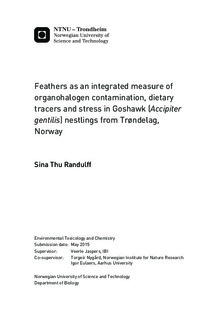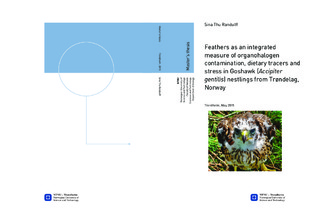| dc.description.abstract | Because of their high sensitivity and wide distribution, predatory birds have proven useful as sentinel species for monitoring exposure of organohalogen contaminants (OHCs). Nestling feathers have been evaluated as valid non-destructive sample matrices for OHCs, and are also believed to be useful biomatrices for the detection of effect parameters of OHC exposure. In this thesis, we investigated the prevalence of OHCs in body feathers, blood plasma and preen oil of Goshawk nestlings (Accipiter gentilis) from Trøndelag, Norway. Additionally, the suitability of using feathers as an integrated biomarker for OHC exposure and effects was assessed by simultaneously detecting stable isotopes (SIs; delta 13C and delta 15N) and corticosterone (CORT) in feathers. Polychlorinated biphenyls (PCBs), organochlorinated pesticides (OCPs) and polybrominated diphenyl ethers (PBDEs) were detected in body feathers (median: 22.3, 19.2 and 1.63 ng g-1 dw, respectively), blood plasma (median: 7.55, 6.23 and 0.50 ng g-1 ww, respectively) and preen oil (median: 748, 606 and 18.4 ng g-1 ww, respectively). Strong, significant correlations between the OHC concentrations in the three matrices indicated that feathers and preen oil reflect the internal circulating blood levels of most OHCs. Delta 13C was found to be the best predictor of OHC accumulation in feathers, indicating that the Goshawks dietary carbon source is of higher importance in predicting OHC exposure than trophic level, although not significant. Variation in CORT was best explained by a positive relationship to PCBs and age (not significant). Overall, this thesis presents, for the first time, an integrated measure of OHCs, SIs and CORT in Goshawk feathers. This methodological approach looks promising, and may provide increased understanding to how ecological, toxicological and physiological factors are interrelated during the whole nestling stage. | |

